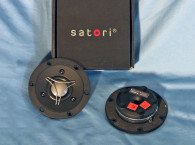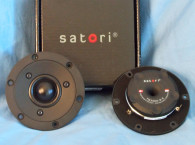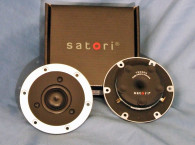
This month, SB Acoustics sent Voice Coil another version of its high-end 29mm Beryllium diaphragm neodymium dome, the Satori TW29BNWG-4 (Photo 1 and Photo 2). What primarily differentiates this model (also available in an 8Ω version) is the incorporation of a 170mm diameter waveguide on the Satori TW29BN tweeter, hence the model name Satori TW29BNWG.

Features for this transducer include the 170mm diameter aluminum waveguide (for controlled directivity), an 8mm wide coated cloth surround, a 29mm Beryllium diaphragm, dual copper caps on the T-shaped pole piece for reduced voice coil inductance and minimum phase shift, dual balanced compression chambers, non-reflective optimally damped rear cavity, CCAW round voice coil wire, 0.25mm Xmax, 97dB sensitivity, a foam mounting gasket, and gold-plated terminals. I should note that the SB waveguide (you see this type of waveguide frequently used in studio monitor designs) can also be used with other dome materials, such as cloth or Textreme (TPCD).
Testing commenced using the legacy LinearX LMS analyzer to produce the 300-point impedance sweep illustrated in Figure 1. The resonance occurs at a fairly low 678 Hz. With a 3.1Ω DCR (Re), the minimum impedance for this tweeter is 3.3Ω at 4.6 kHz.

Following the impedance testing, I recess mounted the tweeter in an enclosure that had a baffle area of 14”×8.5” and measured the on- and off-axis frequency response again using the Loudsoft FINE R+D analyzer (courtesy of Loudsoft) and the GRAS 46BE ¼” microphone (graciously provided by GRAS Sound & Vibration) set up to measure the 200Hz to 40kHz frequency response (using a 192kHz sampling rate) at 2V/0.5m, normalized to 2.83V/1m. Data was then acquired with sweeps at 0°, 15°, 30°, and 45°.
Figure 2 shows the on-axis response of the Satori TW29BNWG, which measured ±2.5dB from 394Hz to 9kHz and ±3.3dB from 394Hz to 17kHz with the Beryllium response going out to 40kHz. As with CD horns, waveguides usually require some kind of equalization to make them more flat. Passively, it generally can be accomplished with a parallel capacitor with the tweeter attenuation resistor, providing the resistance is at least 4Ω or more. Actively with DSP, a shelving filter can easily level out this response.

Figure 3 gives the on- and off-axis response of the Satori TW29BNWG-4 Beryllium tweeter. Figure 4 shows the off-axis curves normalized to the on-axis response. Figure 5 provides the CLIO 180° polar plot (measured in 10° increments with 1/3 octave smoothing). The two-sample SPL comparison is illustrated in Figure 6, indicating the two samples were closely matched to within slightly less than 0.3dB throughout its operating range to 20kHz.




For the next test procedure, I initialized the Listen SoundCheck AudioConnect analyzer along with the Listen SCM-2 ¼” microphone (all provided courtesy of Listen, Inc.) to measure the impulse response with the tweeter recess mounted on the same test baffle. Importing this data into the Listen SoundMap software produced the cumulative spectral decay (CSD) waterfall plot given in Figure 7. Figure 8 uses the same impulse response to produce a Short Time Fourier Transform (STFT) displayed as a surface plot. For the last SoundCheck test protocol, I set the 1m SPL to 94dB (1.69V) using a noise stimulus and built-in SLM, and measured the second and third harmonic distortion with the microphone placed 10cm from the dome diaphragm (Figure 9).



The build quality of the Satori line is definitely appropriate to the high-end two-channel home theater or studio monitor market. I also know that Frank Nielsen and Ulrik Schmidt at Danesian Audio listen obsessively to various iterations of a driver as they go through the development process, so I have no doubt that this tweeter performs admirably as do all of the Danesian designs produced by SB Acoustics. For more information about the SB Acoustics drivers, visit www.sbacoustics.com. VC
This article was originally published in Voice Coil, June 2023.







